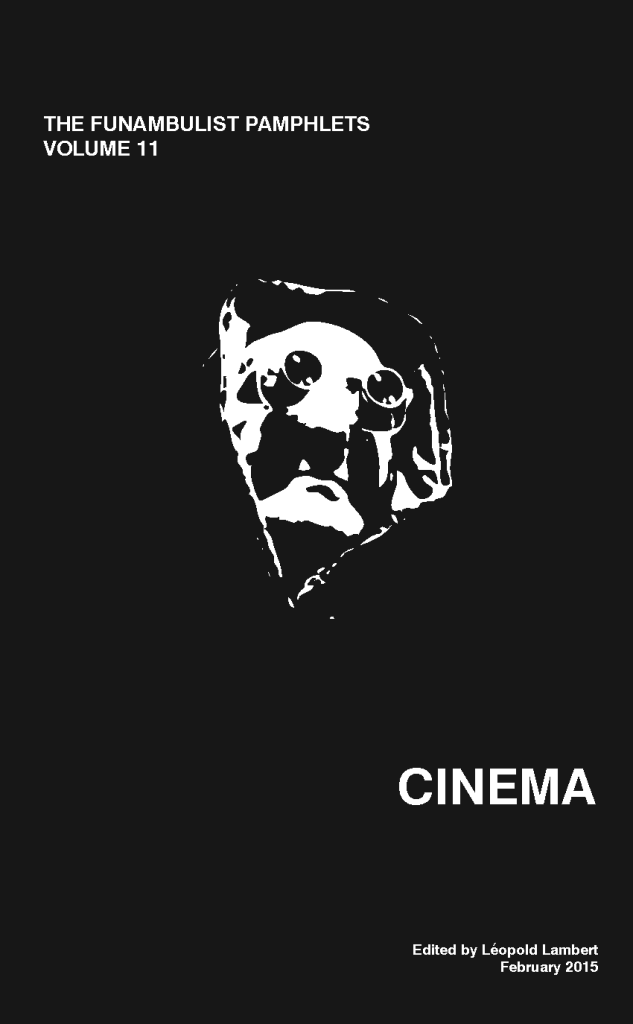The Funambulist Pamphlets is a series of small books archiving articles published on The Funambulist, collected according to specific themes. These volumes propose a different articulation of texts than the usual chronological one. The eleven volumes are respectively dedicated to Spinoza, Foucault, Deleuze, Legal Theory, Occupy Wall Street, Palestine, Cruel Designs, Arakawa + Madeline Gins, Science Fiction, Literature, and Cinema. See all published pamphlets HERE.
Volume 11 is devoted to the topic of Cinema: Spike Lee, Béla Tarr, Michelangelo Antonioni and the many other filmmakers named in this volume do not seem to have much in common at first sight; nevertheless, considered through the interpretation of a Spinozist materialist philosophy, their films might have something to say to one another. Take the mud of Red Desert (Antonioni), the volcanic slopes of The Bad Sleep Well (Kurosawa) and the soil of Pina Bausch’s Rite of Spring magnified in Pina (Wenders), for example. What these material manifestations have in common is that they are all in relation with bodies, themselves assemblages of moving matter. Similarly, consider Spike Lee’s dolly shot, Orson Welles’s labyrinth, Béla Tarr’s entropy, and Peter Watkins’s democratic improvisations: they all manifest the power of immanence and its inexorability. These films involve no deus ex machina; everything in them comes ‘from the ground’ in a continuous refusal of a celestial or other form of transcendence. Developing this kind of reading of these films allows us to avoid a traditional chronological reading of history of cinema in favor of another, one more dedicated to the philosophical vision of the world that cinema triggers.
Vol. 11_Cinema includes: Introduction: The Cinema Papers — La Haine: Banlieue and Police — Paris Is Burning: Gender, Sexuality and Race’s Performativity — Coriolanus: State of Exception — World War Z: The Zombie Is a Human You Have the Right to Kill — The Act of Killing: What Constitutes the Act of Killing? — Hunger: The Body at War — The Diary of an Unknown Soldier & The Forgotten Faces: Two Films by Peter Watkins — La Commune (Paris, 1871): Democratic Cinematographic Construction — Sleep Dealer: Separating the Body and its Labor Production — Even the Rain: What Kind of Leftist Do We Want to Be? — Dogtooth: Emancipation from a Sadian Patriarchal World — The Exterminating Angel: We Must Become Claustrophobic Architects — Un Chien Andalou: Dream as True Horror — The Trial: The Kafkaian Immanent Labyrinth as Postmortem Dream — Enter the Void: Post-Mortem Wandering — Holy Motors: Phenomenological Introspection — The Turin Horse: Entropy of Mind and Matter — Red Desert: Corrupted Materials — Gravity: An Ode to Gravity — Pina: The Weight of the Body Dancing — Wings of Desire: Der Erzähler (the Storyteller) — Akira Kurosawa: Applied Spinozism — Spike Lee: The Dolly Shot as Inexorability of Immanence
The Funambulist Pamphlets is published as part of the Documents Initiative imprint of the Center for Transformative Media, Parsons The New School for Design, a transdisciplinary media research initiative bridging design and the social sciences, and dedicated to the exploration of the transformative potential of emerging technologies upon the foundational practices of everyday life across a range of settings.



